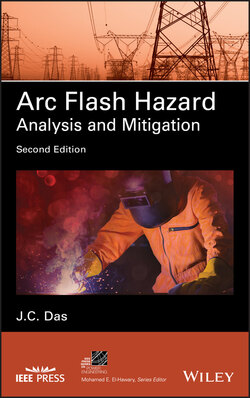Читать книгу Arc Flash Hazard Analysis and Mitigation - J. C. Das - Страница 29
1.9 PERSONAL PROTECTIVE EQUIPMENT
ОглавлениеNFPA table 130.7(C)(16) describes the PPE characteristics for hazard risk category of 0, and 1 through 4. These are shown in Table 1.8.
The standard ASTM F1506 [35] calls for every flame-resistant garment to be labeled with an arc energy rating, ATPV (arc thermal performance exposure value). The rating of the garment is matched with the calculated incident energy release level. The test method of determining the ATPV specifies the incident energy on a multilayer system of materials that results in a 50% probability that sufficient heat transfer through the test specimen is predicted to cause onset of second-degree skin burn injury (see Reference [9]). Arc rating is reported as the minimum of ATPV or EBT (breakopen threshold). EBT is defined in ASTM F1959-06.
The maximum incident energy for which PPE is specified is 40 cal/cm2 (167.36 J/cm2). It is not unusual to encounter energy levels much higher than 40 cal/cm2 in actual electrical systems. Standards do not provide guidelines for higher incident energy levels. Incident energy reduction techniques can be applied; otherwise, it is prudent not to maintain such equipment in energized state.
TABLE 1.8. Protective Clothing Characteristics
Source: NFPA 70E [17]. (All details in the NFPA table have not been reproduced.)
| Hazard Category | Clothing Description | Range of Calculated Incident Energy | Arc Rating o PPE, cal/cm2 |
| 0 | Nonmelting, flammable materials, that is, untreated cotton, wool, rayon, or silk, or blends of these materials, with a fabric weight of 4.5 oz/yd2 | 0 ≤ E ≤ 1.2 | N/A |
| 1 | Arc-rated clothing, minimum arc rating of 4 cal/cm2 | 1.2 < E ≤ 4 | 4 |
| 2 | Arc-rated clothing, minimum arc rating of 8 cal/cm2 | 4 < E ≤ 8 | 8 |
| 3 | Arc-rated clothing selected so that the system rating meets the required minimum arc rating of 25 cal/cm2 | 8 < E ≤ 25 | 25 |
| 4 | Arc-rated clothing selected so that the system rating meets the required minimum arc rating of 40 cal/cm2 | 25 < E ≤ 40 | 40 |
A category 4 PPE outfit looks like a space suit with face hood, eye shields, cover, and gloves. It restricts the mobility of a worker to perform delicate tasks, for example, maintenance work on terminals and wiring.
Thus, not only an accurate calculation of incident energy level, but its reduction in the planning and design stage and selection of appropriate protection and relaying of electrical systems are gaining importance [36].
A very significant change in NFPA70E 2012 from 2009 is the redefinition of PPE hazard risk categories. This will be based on developing a clothing system meeting a specific tested cal/cm2 level and comprised of arc-rated materials. Suppose that an 8 cal/ cm2 protection is required; this can be achieved by:
8-cal/cm2 arc-rated pants and shirts
4-cal/cm2 treated pants and shirts and 4 cal/cm2 arc-rated overall
8-cal/cm2 arc-rated overall cotton shirts and pants.
It is the total level of arc-rated protection that matters. To achieve 8 cal/cm2 of the example being discussed, any 8 cal/cm2 system of one layer or more is acceptable. Natural fiber clothing like cotton, wool, and silk are still allowed but cannot add to the protection level because of risk of ignition. A note of caution is required in interpretation: a 4 cal/cm2 arc-rated shirt and another 4 cal/cm2 arc-rated shirt put together do not add to 8 cal/cm2. When layers are used, the total system must be tested to get the total arc rating, though most often the testing may prove that even greater protection may be provided than the arithmetic sum of the two layers. Also, layering of clothing that is not arc-rated cannot be used to increase arc rating of the clothing. See appendix H of NFPA 70E.
In NFPA 70E 2012, the hazard risk category (HRC) 2* is eliminated. All HRC 2 tasks will require the use of a balaclava under an arc-rated face shield or the use of an arc-rated hood. Commercially, arc-rated outfits even up to 100 cal/cm2 are available, still for category 4 applications.
